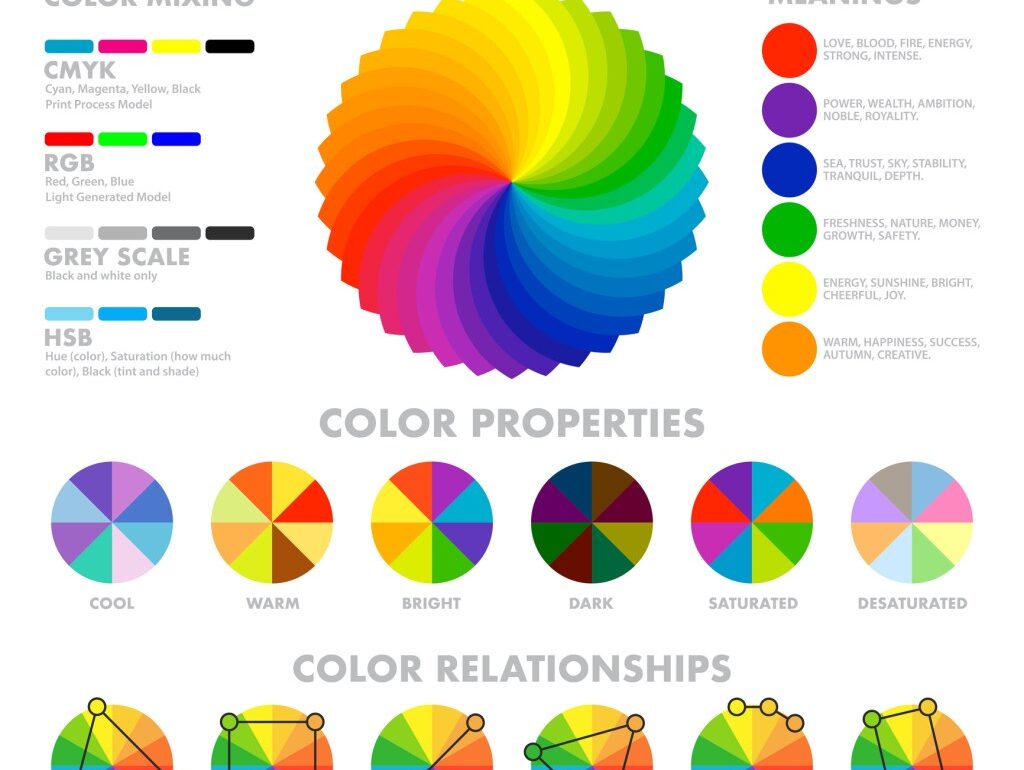Did you pay attention in art class when learning about the color wheel and how it works? If you thought it wouldn’t be helpful back then, it turns out when it comes to camouflaging facial flaws like redness, dark circles, sallow skin and more, that color wheel can work magic for your skin, say makeup experts. And it’s all part of a technique called color correction. Keep scrolling to learn how to color correct your complexion with tips from the pros.
What is color correction?
“To color correct, one has to understand color theory, which always goes back to the color wheel and understanding what makes a color, knowing what the primary colors (red, yellow and blue), secondary colors (orange, green and violet/purple) and tertiary colors (mixing a primary and secondary color) are,” explains makeup artist Genn Shaughnessy.
In basic terms, color correcting uses tinted makeup (specifically, color-correcting makeup) to help balance skin discolorations, such as dark circles, redness or sallowness. Unlike concealers, which conceal, color correctors work their magic by visibly neutralizing unwanted tones. At times, color correcting can be as complicated as contouring, especially if you don’t understand how to do it properly. Here, we get to the bottom of the color-correcting conundrum.
Your skin tone is determined by how much melanin, or pigment, is made by melanocyte cells in the skin’s outer layer (called the epidermis). The more melanin produced, the darker the skin tone. Because skin tone can change as you age, there can be a learning curve for color correcting. Some main culprits of skin color and texture changes are sun damage, hormonal changes, certain medications and aging. This means your color-correcting needs are likely ever-evolving.
How does the color wheel work?

The color wheel visually represents colors, with hues arranged according to wavelength. It allows color relationships to be represented geometrically and shows the relationship between primary, secondary and tertiary colors.
Complementary colors are pairs of opposite colors, such as red and green or blue and orange. “Using complementary colors strategically in makeup application can create striking contrasts that enhance certain features. One color can also cancel out another. This is how color theory works,” explains Shaughnessy.
The general rule of thumb, says Shaughnessy, is to look at the color wheel, and whatever color you’re trying to correct, you’ll use the color that’s exactly opposite it on the wheel. But we’ve made it easy for you and broken it down here, pinpointing the most common skin tone concerns and their solutions.
How to color correct ruddy, splotchy skin: Green concealer

Actress Cynthia Nixon, 57, has said she is one of the estimated 16 million Americans who suffer from Rosacea, which is just one of many conditions that can cause inflamed, ruddy skin and redness in areas such as the cheeks.
The spokesperson for the National Rosacea Society avoids red wine and spicy food to not exacerbate her condition. but also likely color corrects her skin tone with green concealer, which neutralizes and diffuses redness.
Whether from breakouts, rosacea flare-ups or broken capillaries, redness can peek through the foundation and sap our confidence. What can help? “Green is opposite red on the color wheel, so applying a green primer will instantly cancel out ruddiness,” says celebrity makeup pro Amy Zdunowski-Roeder.
A green color corrector Shaughnessy likes: Tarte’s Shape Tape Corrector (Buy from Ulta, $30) to combat and camouflage ruddy tones inconspicuously.
How to: Apply a green concealer to the red-prone areas like cheeks and the tip of the nose, blend and then layer on your foundation or concealer. “It may be trial and error exactly how much green you need to apply or whether you need to layer it,” says Shaughnessy.
YouTuber Megs Cahill demonstrates how to use green concealer correctly:
How to color correct sallow skin: Purple primer

Sometimes, an underlying medical condition could be the cause of yellowish, sallow skin (which you should always get checked out with your doctor if you’re concerned), but even just eating a lot of beta carotene (found in carrots, mangos and beets) can cause the skin to cast a yellowish hue.
Nicole Kidman, 56, is very fair-skinned with yellow undertones. Because she’s also blonde, she can look pale and washed out — but it’s not as simple as swiping on some blush. First, she should color-correct by applying a purple-toned primer all over her face.
“The violet color, opposite of yellow on the color wheel, counteracts any sallowness, restoring a youthful glow fast,” says Zdunowski-Roeder.
Check out TikToker @faceatelier’s video instructions on how to combat sallow skin using purple primer:
One we like: The L.A. Girl HD Pro Corrector Concealer in the Lavender shade (Buy from Ulta, $5.49) neutralizes unwanted yellow tones and sallowness.
How to color correct dark under-eye circles: Peach or orange primer

Wonder why your under-eye concealer doesn’t entirely mask those dark, blue-toned shadows? You may be missing out on an essential secret weapon.
To make them vanish, Zdunowski-Roeder suggests covering them with a primer that is the shade of their color wheel opposite: orange (for medium to dark skin tones) or peach (for fair to light skin tones).
On social media, Drew Barrymore, 48, complained of dark under-eye circles and raved about Olay Eyes Ultimate Eye Cream (Buy from Olay, $29.99), which has a pinkish-peachy hue. “This on its own not only acts as a concealer, brightening and lightening the effect and look of a dark circle, but it’s also taming the dark circle while you’re wearing it,” Barrymore explained in her Instagram video. “It’s sort of a perfect alchemy of skin care as makeup.”
How to: To apply, dot primer under the eyes in an upside-down triangle, then blend out with a makeup sponge (this further helps shadows recede). Next, top with a light layer of concealer; blend.
You can take Drew’s recommendation above if you have fairer skin, or Shaughnessy likes the orange shade in the J.Cat Color Corrector Quad Spectrum Palette (Buy from Ulta, $6.99) to cancel dark circles and spot-treat dark spots in medium to brown skin.
Check out YouTuber Nina Ubhi’s video tutorial on how to color-correct dark circles using an orange color corrector:
First For Women aims to feature only the best products and services. We update when possible, but deals expire and prices can change. If you buy something via one of our links, we may earn a commission. Questions? Reach us at shop@firstforwomen.com
For more makeup tips, click through these stories:
Here’s the Best Red Lipstick for Your Skin Tone + The Makeup Artist Trick to a Plumper Pout
Celebrity Makeup Artists Say Adding *This* to Your Makeup Routine Is a Game-Changer
Dermatologists: If You Aren’t Double Cleansing, You’re Going to Bed With a Dirty Face
This post was originally published on this site be sure to check out more of their content.









